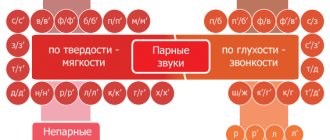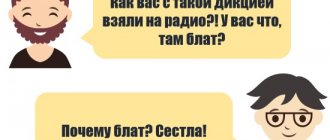When to start training?
In fact, the initial stage of learning occurs at an even earlier age, when we teach the baby to distinguish between different sounds. Then we study all the letters of the alphabet, give the concept of vowels and consonants, and teach the child to determine the presence of each of them by ear. Only after this will the baby be able to understand the difference between voiced and deaf and learn to hear them in words.
That is, first you need to develop phonemic hearing in a preschooler - that same ability to isolate individual sounds from speech. How to do it?
- Teach to respond to the sound of rattles by turning your head in their direction.
- We teach a grown-up toddler to listen to nature outside the window: let him close his eyes and describe what he hears (the hum of the wind, the rustling of leaves, the chirping of birds, the noise of cars, barking dogs, etc.).
- We do the same with household appliances at home: let them distinguish the sound of a hairdryer, vacuum cleaner, kettle, refrigerator.
- We play at the zoo: the mother imitates the voices of different animals and birds, and the child guesses them, and then vice versa.
- Let the blindfolded child determine what sounds: a bell, a tambourine, a whistle, etc.
- After he has learned all the letters, you can teach him to identify their presence in words (for example, have him clap or stand up if he hears a given sound).
That is, before studying the voicedness - deafness of consonants, a preschooler must:
- know all the letters of the alphabet, their order, quantity;
- distinguish vowels from consonants;
- have developed phonemic awareness.
All these skills can be developed in a preschooler by the age of 5–6 years.
In order for your baby’s phonemic hearing to develop correctly, try to communicate with him as much as possible, and also make sure that there is no constant background noise around him (a TV that doesn’t turn off, a music player).
Let's take on the consonants
How to teach a preschooler to distinguish between voiced and voiceless consonants? Simply forcing him to learn them by heart (that is, memorize them) is the wrong move. Indeed, with this approach it will be very difficult for him to apply this knowledge in practice. This means that he needs to make sure that he understands the difference between them, learns to hear them, and identifies them by specific signs.
As you know, information is remembered much easier if, when studying it, a person uses different senses: vision, hearing, touch... It is necessary to explain to the child that consonants in the Russian language are divided into voiced and voiceless, depending on whether the voice is involved in their pronunciation. To make this easier to understand, let’s connect the sense of touch: let the child put his palm to his throat and pronounce any voiced sound, and then a voiceless sound (for example, D and X). The voiced one creates a vibration of the vocal cords, which the palm will feel, but the voiceless one does not.
You can distinguish them by ear. If you cover your ears with your palms and then pronounce a sound in a low voice, then sonority can be determined by the sound, and deafness - by noise. Be sure to pronounce them with your voice, and not in a whisper, otherwise most of the sounds will be deaf! After playing this way, the child will understand the difference.
The basis of sound-letter analysis is the classification of sounds of the Russian language
The basis of sound-letter analysis is the separation of sounds of the Russian language.
First, we divide all sounds into vowels and consonants .
Vowel sounds: everything you need to know about them
Vowels are formed by the voice (hence the name). sing them . In addition, when pronouncing them, the air flow passes through the oral cavity freely, without encountering obstacles that add noise to the voice.
There are only 6 vowel sounds in the Russian language - [a], [o], [u], [e], [i], [s]. At least, this is how the student is required to answer. In fact, there are more vowel sounds, but schoolchildren use a simplified version. Therefore, we will focus on it.
And it seems, where is the “ambush” here? The letter A stands for the sound [a], the letter O stands for the sound [o]. But it's not that simple. The student must take into account that vowels can be stressed or unstressed. The latter occur in an unstressed syllable. And if O is in the unstressed position, then it denotes the sound [a]. E in an unstressed position is pronounced like [and]. The letters A, U, and I do not change their quality in an unstressed position.
Another nuance concerns the use of the letter and after sibilants and c. Here we write and according to the rules of spelling, but we hear the sound [s]. For example, in the word “machine” the letter I stands for the sound [s]. Therefore, parents are often indignant that when studying phonetics, the child’s head becomes confused and he begins to make mistakes.
There are “special” letters in the Russian language - these are E, Yo, Yu, Ya. And the trick is that they can represent different sounds depending on their position in the word.
They designate two sounds if they are at the beginning of a word, after a vowel, or after a soft or hard sign. In this case, the first sound will be [th], and then comes the corresponding vowel: I - [a], Yu - [y], E - [o], E - [e]. Well, the letter E in an unstressed position is the same as E gives the sound [i].
If these letters come after a consonant, they soften it (except for always hard ones). Then the consonant [th] does not appear.
Consonants
There are much more consonants in the Russian language. There are more of them than letters, because the same letter can, depending on subsequent sounds, mean both a soft sound and a hard one.
“Soften” the consonant letters e, ё, yu, ya, i. At the same time, “not all consonant sounds can soften, but only those that have a soft pair. These are b, c, d, d, h, j, l, m, n, p, r, s, t, f, x. Each of these letters can represent either a hard or soft sound. For example, in “to be - to beat” the letter B in the first case denotes the sound [b], and in the second - [b']. Please note that the softness of the sound is indicated by a “comma on top”.
Among the consonants there are always hard ones - Ж, Ц, Ш. Regardless of the letters that come after them, they remain hard. And always soft - Y, Ch, Shch.
Another complication is that sometimes consonants can become soft if they are followed by another soft consonant. For example, in the word “drummer” the soft [ш'] is softened by the N coming in front of it.
That is why, in the process of sound-letter analysis, you should say the word out loud several times, carefully listening to its sound. This will help avoid mistakes.
Voiceless and voiced consonants
Another important characteristic of consonant sounds. And again we have letters that form deaf-voiced pairs - B-P, V-F, G-K, D-T, Zh-Sh, Z-S. These letters, depending on their position in the word, can represent different sounds.
That is, the letter B at the end of a word and before a voiceless consonant will indicate the sound [p]. We write DUB and pronounce [dup]. Sometimes voiceless consonants can be “voiced” if they are followed by a voiced consonant, for example, in the word REQUEST, the letter C denotes the sound [z]. Check, say this word out loud.
There are consonants, always voiceless . Everything is simple with them. This is X, C, Ch, Shch .
And there are always voiced ones - Y, L, M, N, R. These letters denote only a voiced consonant sound, regardless of the “surroundings”.
The difference between voiceless and voiced consonants is the presence of voice. Voiced ones consist of voice and noise, deaf ones consist only of noise.
Since the voice is formed by vocal cords, the position and operation of which we cannot see, we will use the following technique. Let's pronounce a voiced consonant, for example, M or R. And at this moment we will put our palm to our throat. A characteristic vibration will be felt - this is the vocal cords “turned on”. If you make a dull sound, there will be no such vibration.
Another way is to pronounce the sound in a whisper, without a voice. A dull sound will not change its quality. And the voiced double “will turn” into its deaf “partner”, that is, instead of B we will hear [f].
Let's sort out the pairs
To make it easier to remember paired and unpaired deaf and voiced sounds, we connect vision. Let's visualize pairs of consonants in table form.
For this purpose, you can compose a phonemic tale about how vowels and consonants lived in the Russian language, some consonants had siblings, while others did not. We draw two icons on the left side of the sheet that will indicate voicedness and deafness (for example, a bell and headphones). Opposite the bell we write the ringing ones, opposite the headphones – their deaf brothers. Count together how many pairs of brothers are there in our language? That's right, 6. Let the child visually see which letters are paired.
Sometimes brothers change places in words. For example, a paired voiced voice at the end of a word becomes voiceless (tooth, shore, train), and paired voiced voices before other voiced ones become voiced (backpack, request).
But there are consonants that do not have brothers. They do not turn into anyone and therefore are friends only with “their own”. Now in the table we add unpaired voiced ones above the voiced ones, and unpaired voiceless ones under the voiceless ones. With such visual perception, it will be easier for the child to remember the rule: M, L, N, R, Y - only voiced ones, X, C, Ch, Shch - only deaf ones.
Consultation for parents “How to teach children the sound analysis of words”
Teaching children to read and write in kindergarten is carried out using the analytical-synthetic method. This means that children are introduced to the sounds of their native language first and then to the letters.
When teaching both writing and reading, the initial process is the sound analysis of oral speech, that is, the mental division of a word into its constituent sounds, establishing their quantity and sequence.
A violation of sound analysis is expressed in the fact that the child perceives a word globally, focusing only on its semantic side, and does not perceive the phonetic side, that is, the sequence of its constituent sounds. For example, an adult asks a child to name the sounds in the word JUICE, and the child answers: “orange, apple...”
To read a word means using a combination of individual letters that reflect the order of sounds in the word, synthesizing them so that they form a real, “living” word.
Children with problems in speech development, who have impaired pronunciation of phonemes and their perception, especially experience difficulties in sound analysis and synthesis. They can be expressed to varying degrees: from mixing the order of individual sounds to a complete inability to determine the number, sequence or position of sounds in a word.
Teaching the sound analysis of a word is the main task of the preparation stage for learning to read and write and involves: determining the number of sounds in a word, the phonetic characteristics of sounds (the ability to differentiate vowels and consonants, voiced and voiceless, hard and soft), determining the place of a sound in a word.
Dear parents, remember:
1. Sound - we hear and pronounce.
2. We write and read letters.
3. Sounds are vowels and consonants.
Vowel sounds can be sung with a voice, while the air coming out of the mouth does not meet any obstacles. Consonant sounds are sounds that cannot be sung, because... the air coming out of the mouth when pronouncing them meets an obstacle.
There are six vowel sounds: A U O I E Y
There are ten vowel letters: A U O I E Y - correspond to the sounds and four are iotized, which indicate two sounds: Ya-ya, Yu-yu, E-ye, Yo-yo.
Vowel sounds are indicated in red on the diagram.
Consonant sounds are voiced and unvoiced. A dull sound is formed without the participation of the vocal folds; we explain to children that when we pronounce
a dull sound, the voice sleeps, and when pronouncing ringing sounds the voice rings (Put your hand on the neck or cover your ears with your hands). In the diagram, voiced sounds are indicated by a bell.
Voiced sounds: B, V, G, D, Zh, Z, J, L, M, N, R.
Voiceless sounds: K, P, S, T, F, X, Ts, Ch, Sh, Shch,
Consonant sounds are soft and hard.
Always hard consonants: Zh, Sh, Ts.
Always soft consonants: Y, Ch, Shch.
Hard sounds are indicated in the diagrams in blue, soft sounds in green.
Sample game tasks.
Game “Catch the sound” (from a series of sounds, from a series of syllables, from a series of words).
Objective: to develop auditory attention, phonemic hearing.
The adult names the sound, and the child picks up a blue or green square. Then the word. If you hear a hard sound at the beginning of a word, you need to raise the blue square, if it’s soft, you need to raise the green one (Snow, winter, skiing, etc.).
Game “How many sounds are hidden in the word?”
Post a diagram of the word CAT.
— How many sounds are in the word CAT? (The word CAT has three sounds)
— What is the first sound in the word CAT? (first sound [K])
- What is the sound [K]? (the sound [K] is consonant, deaf, hard).
- Which square on the diagram will indicate the sound [K]? (Blue square).
— What is the second sound in the word CAT? (Second sound [O])
-What sound is [O]? (Sound [O] vowel).
- Which square on the diagram will indicate the sound [O]? (Red square).
— What is the third sound in the word CAT? (Third sound [T]).
- What is the sound [T]? (Sound [T] – consonant, hard, deaf).
Which square on the diagram will indicate the sound [T]? (Blue square).
— The sounds have become friends. What happened? (CAT).
- What letter will we use to denote the sound [K]? (Letter K).
What letter denotes the sound [O]? (Letter O).
What letter denotes the sound [T]? (Letter T).
— The letters have become friends. What happened? (CAT).
It is important that the child learns what the sound of speech is, can differentiate sounds, and divide words into sounds and syllables. Only then will he be able to easily master the skill of reading.
Letters are a graphic symbol of sounds. We often come across the fact that children are taught to read letter by letter, i.e. children, seeing a letter, pronounce its name, and not the sound: pe, re... The result is “keote”, instead of “cat”. Children have difficulty understanding the rules of voicing letters and letter combinations. This creates additional difficulties in teaching children to read.
The method of teaching reading in kindergarten involves naming letters by their sound designations: p, b, k.... This makes it much easier for children to master reading skills. In order for the child to better understand the graphic appearance of letters and to prevent dysgraphia at school (dysgraphia is a written language disorder), the following tasks are recommended:
- “What does the letter look like?”
— In a series of letters, circle the given letter.
— Laying out letters from counting sticks, from string on velvet paper, sculpted from plasticine, etc.
- Circle the letter by dots, shade the letter, complete the letter.
Dear parents, follow the teachers’ instructions very carefully when completing tasks in the notebook, do not complicate the tasks at your own discretion. Remember that the requirements of the kindergarten and the family must be the same!
Bibliography.
- Alexandrova, T.V. Living sounds, or Phonetics for preschoolers: Educational and methodological manual for speech therapists and educators. St. Petersburg: Detstvo-press, 2005.
- Tkachenko, T.A. Formation of sound analysis and synthesis skills. M.: Gnom i D, 2005.
Consolidating knowledge
You can consolidate the material covered by asking your child to compile and fill out such a table. This will also connect motor memory.
A good way to learn to distinguish consonants is to play “dispersing” sounds into “apartments” in a drawn “house”. For example, voiced unpaired ones - in apartments with blue windows, paired ones - with yellow and orange ones, unpaired unpaired ones - with green ones.
It is useful to look for different letters in words. You can give your child examples of words with voiceless consonants, then with voiced consonants, and show that both words can end at the end. You can show how the sorceress Phonetics turns deaf into voiced and vice versa.
Let the sign drawn by the child always hang before his eyes, so that he can periodically return to it and repeat the material. For a child, first of all, it will be a game, but with its help he will study an important topic that will be very useful for him in his studies.








